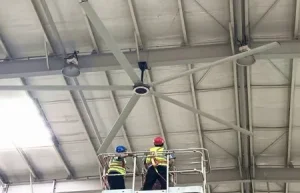Stale air in large commercial and industrial facilities creates discomfort and soaring energy bills. This frustration grows when ceiling fan fail to deliver consistent air circulation. The solution? Discover how an HVLS fan—a high-volume, low-speed fan—can effectively ventilate your entire ceiling area and maintain a pleasant working environment.
To calculate HVLS ceiling fan size, first measure the square footage of your space and ceiling height. Choose a diameter that suits the room size—for example, 14 feet to 24 feet blades for large industrial spaces. Factor in ceiling obstructions, occupant density, and desired air circulation. This approach ensures the right size and optimal performance for improved air quality and energy savings.

Calculate fan size
ceiling fan systems have long been the go-to for temperature control in smaller areas. However, an HVLS fan (High-Volume, Low-Speed) is a game-changer for large industrial or commercial facilities. Unlike small fans that spin rapidly, hvls ceiling fans use slow, wide blades to move massive amounts of air gently.
Why the Different Approach?
Insight: Many experts view hvls ceiling fans as industrial workhorses. These large industrial fans are used to distribute both cool and warm air from the ceiling, making them indispensable in industrial settings and big open areas.
Choosing the ceiling fan size is crucial when aiming for optimal air circulation. If your ceiling fan is too small, pockets of stagnant air remain. If it’s too big or the fan is installed too high, you might experience poor performance and wasted energy. Getting the right hvls ceiling fan size ensures consistent airflow across your space without overdoing it.
Tip: For a large warehouse of 30,000 square feet, a 24 feet HVLS fan can often handle the job. Meanwhile, a more modest 10,000-square-foot facility may only require a 14 feet or 16-foot diameter solution.
Because different buildings vary in layout and occupant density, referencing a hvls ceiling fan size guide is the best place to start. A size ceiling fan size chart typically matches fan diameter or ceiling fan blade size to the approximate coverage area.
| Diameter of a Fan | Coverage (Sq. Ft.) | Recommended Ceiling Height |
|---|---|---|
| 8–12 ft | Up to 5,000 | 12–15 ft |
| 14–18 ft | 5,000–10,000 | 15–25 ft |
| 20–24 ft | 10,000+ | 25 ft and above |
following chart helps you quickly estimate which size you’ll need per fan. Keep in mind these are guidelines. Actual coverage depends on fan placement, building obstructions, and occupant comfort requirements.
Yes. The height for hvls matters because the higher the ceiling, the more distance the fan blade must push air downward. You want enough clearance so the ceiling fan can disperse air effectively without creating safety hazards.
Minimum Requirements
When the Fan Is Too Low
When the Fan Is Installed Too High
When determining the fan size for your space, you want to choose the right solution for your building’s ceiling configuration, occupant needs, and temperature objectives. Start by assessing the square footage of your space, typical usage patterns, and the ceiling fan or hvls fan style you prefer.
Case Study: A sports center discovered that installing an HVLS fan with a 14 feet diameter drastically improved air quality. By positioning it near mid-court, they harnessed broad coverage and comfort for spectators and players alike.
HVLS fans in sports centers
When it comes to facilities best suited for hvls, you’ll find these fans in industrial spaces, gymnasiums, commercial space is crucial as well, and anywhere large numbers of people gather under a tall ceiling.
Suited for HVLS Ceiling Fans in Different Industries
Note: Many hvls industrial ceiling fans double as industrial air circulators. They ensure a stable climate, saving on HVAC costs while improving staff morale.
Curious how hvls fans work? In a nutshell, the fan’s wide diameter spins at a low speed, producing a gentle column of air. This column expands outward at floor level, displacing stagnant pockets and boosting air circulation from floor to roof.
Quote: “A well-chosen HVLS fan for your space reduces temperature differentials up to 10°F, delivering a comfortable environment,” says an engineer at our hvls fans manufacturing plant.
Our hvls ceiling fan size guide simplifies the process of choosing the right size fan. The crucial metrics revolve around diameter, ceiling height, and fan blade shape.
Size HVLS Fans:
Fan Installation Essentials:
Pro Tip: “The bigger the diameter of a fan, the more area it can cover at a lower RPM,” shares a hvls fan supplier who specializes in industrial applications.
Partnering with a leading hvls fan brand or hvls fan supplier ensures you get expert guidance on fan installation, sizing, and ongoing maintenance. They’ll help you handle complexities like fan operating speeds, number of fans required, and motor specs.
Help You Get the Right system: With so many industrial fans on the market, leaning on a knowledgeable supplier helps you get the right hvls fan for your building’s layout.
Get the Right HVLS Fan
Below, we answer frequent questions about hvls ceiling fan size, ceiling fan requirements, and ensuring the right size for your facility.
How do I know the right fan size for my building?
Begin by calculating the square footage of your space. Use a standard fan size chart facilities best matched with your building type. For instance, a ceiling fan size chart facilities can highlight 8–12 ft fans for up to 5,000 sq. ft or 14–18 ft for 10,000 sq. ft.
What if my fan has an odd number of blades?
Having an odd number of blades, such as five, is common. The ceiling fan blade design remains balanced; it’s just how many manufacturers create lift and reduce noise.
Are HVLS fans are used year-round?
Yes. While fans are used to cool in summer, they can also push warm air from the ceiling down in winter, improving energy efficiency.
What is an eco hvls fan?
An eco hvls fan typically uses advanced motors and minimal power while covering large areas effectively. They are considered industrial air circulators for cost-effective climate control.
Which facilities are best suited for hvls ceiling?
Nearly all large, open, or high-traffic spaces, from gyms to factories, are best suited for hvls ceiling installations. If you have tall ceilings and a need for consistent air movement, hvls ceiling fans are ideal.
A quick reference to help you choose an appropriate fan diameter and coverage zone:
| Square Footage | Fan Diameter | HVLS Fan Size Ceiling Fan | Approx. Coverage |
|---|---|---|---|
| 1,000 – 3,000 | 8 – 10 ft | Smaller Industrial or Gym Spaces | 1 HVLS Fan / 1–2,500 Sq. Ft. |
| 3,000 – 8,000 | 12 – 14 ft | Medium Warehouse or Cafeterias | 1 HVLS Fan / 3–6,000 Sq. Ft. |
| 8,000 – 15,000 | 16 – 18 ft | Large Retail, Sports Centers | 1 HVLS Fan / 8–12,000 Sq. Ft. |
| 15,000 – 25,000+ | 20 – 24 ft | Industrial Work Areas, Factories | 1 HVLS Fan / 15k+ Sq. Ft. |
This chart to get a fan diameter helps you figure out the general size hvls solution you need. Also, consider the room size, occupant load, and your usage patterns.
In a sprawling industrial or commercial space, controlling climate zones can be complicated. With hvls ceiling fans, you achieve uniformity that smaller fans can’t match. This not only keeps employees happy but can also reduce HVAC loads.
Key Reasons
Testimonial: “Installing HVLS fans was a turning point for our distribution center. We saw immediate drops in energy bills and a morale boost,” says a facility manager in the automotive sector.
This step is crucial. For example, if your facility is about 10,000 sq. ft. with a 20 ft ceiling height, you might opt for a 16 ft diameter HVLS solution. Meanwhile, a 30,000 sq. ft. plant with a 30 ft ceiling might need multiple 24 feet fans, or a combination of mid-range diameters to cover specific areas.
Factors to Weigh
Data Insight: In large industrial spaces, each HVLS unit can replace multiple small fans, leading to a simpler layout and fewer maintenance headaches.
Looking to cut down on AC expenses while boosting occupant comfort? HVLS fans are used as industrial air circulators that deliver broad coverage. They differ from smaller “spot-cooling” fans because they move air gently but across a far wider area.
Why HVLS Industrial Fans?
Eco HVLS Fan: An eco hvls fan is an advanced model that lowers electrical consumption further with specialized motors or direct-drive technology.
Reminder: Always consult a hvls fan supplier for professional sizing if you’re uncertain. An ideal fan must fit your environment’s unique parameters.
An hvls ceiling fan size that’s properly matched to your building ensures consistent comfort and can maintain stable temperatures across wide areas. This technique eliminates updrafts, helps push warm air from the ceiling down in cold months, and keeps conditions mild in warmer seasons.
Selecting the right HVLS model is not only about diameter but also about your facility’s purpose, occupant load, and fan operating cycles.
What is the right hvls fan size ceiling for 5,000 sq. ft.?
Look at a hvls fan size ceiling fan around 10–12 ft in diameter of a fan, assuming no major obstructions and a standard ceiling height around 15–20 ft.
Why does the ceiling fan blade size matter?
The ceiling fan blade design and ceiling fan blade size influence how much air is displaced per rotation. A bigger blade covers a larger swath of air, improving the air circulation in fewer rotations.
Does a fan for your space have to be an HVLS model?
If you operate in large or industrial spaces, then yes, an HVLS is typically the best fan for consistent cooling and ventilation. For very compact rooms, a smaller right ceiling fan might suffice.
How many hvls fans help a 30,000 sq. ft. warehouse?
This depends on the fan diameter you choose. You might use one or two 24-ft fans or multiple 18-ft fans. Evaluate obstacles, occupant density, and your budget to decide the number of fans required.
Which brand is a leading hvls fan provider?
We’re proud to be a leading hvls fan manufacturer ourselves, but many recognized industry names exist. Always compare warranties, engineering quality, and references from existing customers before buying.
By applying these guidelines and referencing charts, you’ll know the size fan for your industrial or commercial layout, ensuring your hvls fan is indeed the appropriate fan. With the right fan size, occupant comfort soars, industrial air quality improves, and your facility reaps the financial benefits of an eco hvls fan system. If you have further questions about how to get the right fan or need a custom assessment, we invite you to contact us to get expert advice. We’re here to ensure you’re selecting the appropriate size—one that elevates your environment, from small retail shops to sprawling industrial complexes.

Hi, I’m Michael Danielsson, CEO of Vindus Fans, with over 15 years of experience in the engineering and design industry. I’m here to share what I’ve learned. If you have any questions, feel free to contact me at any time. Let’s grow together!